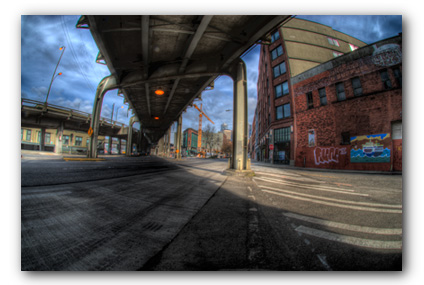We had a great time in Seattle over the weekend.
The show GB was in, That Night Follows Day was playing On the Boards at the Bennke Centre in Lower Queen Anne district.
I spent a lot of the weekend walking around, since the sun decided to make an appearance, and managed to get a few photos.
More snaps from Seattle in this set on Flickr.
We had lots of outstanding food and superb coffee – so thanks Seattle.

I love this image! The fish eye lens is great, and the composition stellar, but I also love the colours. It has a very painterly feel. Did you doctor it? And if so, what program did you use? Gorgeous!!
Hey T,
I use DXO Pro on all my RAW files out of the Nikon. So, I shoot RAW which is a collection of data that you can adjust post – Photoshop opens most RAW files (different cameras use different RAW formats – Nikon’s is called NEF), or you can open with proprietary software from your camera manufacturer. This lets you do things like adjust the exposure, play with colour temp, hue etc. Things you would do in a darkroom.
DXO Pro is software that makes doing all that somewhat easier – and you can copy setting from one photo to a whole folders’ worth (batch). It reminds me of working in the darkroom and I like that a lot (and miss that with digital). I often super-saturate my shots because I’m a child of the 60’s and love the look of old slides and the various film stocks. DXO actually has settings to mimic various stock from Fuji, Kodak, Ilford, etc. So you get the best of both world.
In this case, it’s actually a bit different. This is an HDR process (High Dynamic Range) – basically you shoot at various exposures (from over to under) and then using Photoshop you can process the files (3 or more) so that you can pull up the detail in the shadow bit, but also have the bright bits exposed properly. It can sometimes be a bit freakish looking. There’s a great primer (and how I learned to do it ) here: http://www.cambridgeincolour.com/tutorials/high-dynamic-range.htm I’ve had various good/bad results with it – but I like this one a lot.
Thanks for looking T.
r